Master Gun Fitter Bryan Bilinski Tells You How
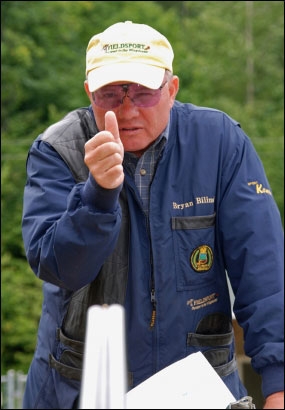
If you’re a right-handed shooter who stands 5-feet, 9 inches, weighs about 165 pounds, has a 33-inch sleeve length and wears a size 40 regular suit coat, you probably think you don’t need to worry much about “gun fit” or even consider ever needing a custom gun fitting.
Why? Because the gun makers of the world have basically declared that you’re their “Mr. Average” and are the benchmark height, weight and physique that they attempt to dimension their gun stocks on with their off-the-rack guns.
But according to seasoned gun fitter Bryan Bilinski, owner of FIELDSPORT, “I know Mr. Average is out there somewhere and he may basically exist, unfortunately I have never met him”.
The good news is that if you’re fortunate enough to order and purchase a truly custom bespoke over/under or side-by-side shotgun that has been fitted to within a whisker of perfection, don’t bother to read on. Just count your blessings and enjoy using a gun that is effortless to mount and one that you’re confident shoots exactly where your eyes are looking.
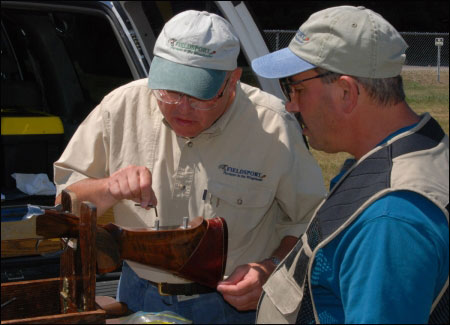 Bryan Bilinski fine tuning a shotgun fit in the field for a client.
Bryan Bilinski fine tuning a shotgun fit in the field for a client.For the rest of us wingshooters and clay target disciples, sooner or later we realize a visit to an experienced, master gun fitter will take our shooting to the next level. It’s the ultimate quest to gain comfort and confidence in our shotgun, with our ability to properly shoot of paramount importance.
A shotgun connects with your body at five points: 1) the recoil pad or butt against your shoulder pocket, 2) your cheek bone ledge mated to the comb of the stock, 3) your back, trigger hand firmly gripping the wrist of the stock, 4) your index finger tip touching the trigger blade and 5) the leading hand, the left hand for us right handed shooters, holding and properly gripping the forearm or barrels.
If all of these points of contact are correct, your shotgun should feel effortless to mount and swing with relative ease but most importantly position your dominant eye perfectly down the rib — making your shotgun shoot exactly where you’re looking.
However, if you need to 1) crush your face down into the stock to achieve eye alignment, 2) lift your face to see over the standing breech, 3) assume some kind of unnatural and uncomfortable stance or posture in order to accommodate yourself to a stock length, (that is unfortunately either way too long or way too short for you), 4) experience way too much felt recoil in either your shoulder pocket or on your cheek bone, 5) you have way too much muscle tension in your neck, shoulders or back, or 6) you consistently miss some type of target presentation and can’t seem to miss others, then you’re a good candidate for a custom gun fitting.
Enter seasoned gun fitter and wingshooting instructor, Mr. Bilinski.
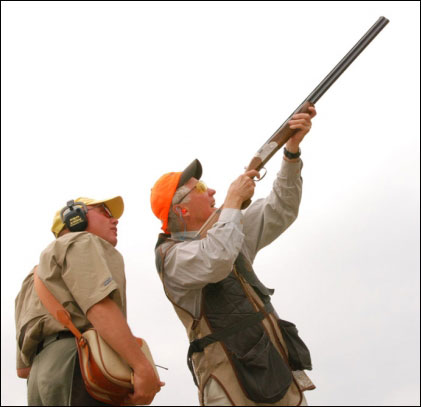 Mr. Bilinski giving a lesson.
Mr. Bilinski giving a lesson.He founded and owns FIELDSPORT Ltd. located in Traverse City, Michigan. He is ranked as one of the top wingshooting instructors and gun fitters in America. More than 30 years of experience doesn’t hurt either. He also claims to be the man who introduced Sporting Clays to the U.S. when he worked for the Orvis Company in the early 1980s.
Despite all the current press and rhetoric about gun fit, he explains that, in fact, the craft of gun fitting is actually quite new to Americans. Our shotgun industry has almost always based gun fit on the principal of Henry Ford’s Model T… “You can have any color Model T you want, as long as it’s black.”
Today, American wingshooters and clay target shooters are more discerning and demanding than ever before. Very few are happy to accept mediocrity in any sport they enjoy. Simply put, they want to hit with “a load of shot” what they should be able to hit with “a load of shot.” When you also add all the new advancements in gun technology, an influx of more women and youngsters into the sport and the search for perfection that consumes more and more shotgun shooters today, you can begin to see why gun fit is quite possibly the last frontier in American wing and clays shooting.
Unfortunately the men or women who actually make a year-round living conducting live-fire gun fittings for clients in the U.S. are ultimately quite rare. From that viewpoint, gunfitting in America is still novel to the shotgun sports.
 A try-gun like this one features minute adjustments for cast, length of pull and drop to help determine a perfect gun fit. (Photo: Hallowell & Co.)
A try-gun like this one features minute adjustments for cast, length of pull and drop to help determine a perfect gun fit. (Photo: Hallowell & Co.)
At the turn of the last century, the bespoke shotgun was simply a matter of course in the United Kingdom for the affluent. If you lived and worked in England, you had a personal tailor and a bespoke shotgun made by the London trade. The aristocracy held a veritable monopoly on shotgun ownership. In fact, most of the best London and Birmingham gun makers employed a gun fitter who worked exclusively for them. This elite group of men conducted private shooting instructions and custom gun fittings at shooting grounds that functioned under prestigious gun maker’s names. These shooting instructors also became experts in a new fitting tool called the “try gun.” Many of these gun fitters and shooting coaches became famous in their own right.
While the British were shooting driven pheasants on their private estates with their bespoke London Best shotguns, gun ownership and the functional use of shotguns here in the U.S. proved more egalitarian. Double guns made by the likes of Parker Brothers, A.H. Fox and L.C. Smith were often sold in hardware and sporting-goods stores. These firearms were primarily used for putting meat on the table while functioning under the roughest conditions. The shotguns were tools, not elegant bespoke art forms. Just as there were no bespoke shovels or picks, the notion of ordering a custom fitted shotgun for most rural based Americans was an unlikely extravagance and a cost-prohibitive luxury.
From the perspective of a professional gun fitter, Mr. Bilinski believes America is still basically “a nation of riflemen.” It’s a fairly easy phenomenon to track. Most likely the first gun you were given was a BB gun with iron sights. The second was a pump or CO2 pellet gun, again with open, iron sights. The third was your 16th birthday present — perhaps a bright and shiny.22 bolt action rifle also with open sights for aiming. By now, you have become a rifleman, learning to shoot by aiming every gun you owned.
When you finally received some shotgunning instructions with a hand trap behind the barn, you were probably told to “put the bead on the clay target” and pull the trigger. And the slippery slope of aiming a shotgun begins. A shotgun is meant to be “pointed” not aimed. You can aim at a sitting rabbit or squirrel out stretched on a limb, but try aiming at a fast flushing grouse or rooster pheasant with a 30-mile-per-hour tail wind. A gun you point must fit perfectly in order to shoot where you look and follow your gift of eye/hand coordination.
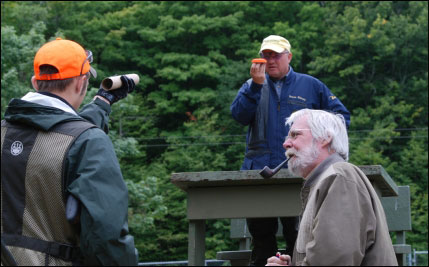 Mr. Bilinski, with the late Michael McIntosh, help a student with eye dominance.
Mr. Bilinski, with the late Michael McIntosh, help a student with eye dominance.We are also not the same sized people or shooters we were pre-World War II. Mr. Bilinski notes that shotgun stocks made for “Mr. Average” from the 1800s to the 1950s were totally different than the stock dimensions needed for the shooters of today. Stocks made for that era of shooter were relatively short in length of pull, 14 inches or less. Stock drop at heel was more pronounced, often averaging 2 ½ inches to 3 inches or more. Cast of the stock was virtually irrelevant, with most stocks Cast “0” or just a 1/16 inch Off +/-. Not only have body types and physiques drastically changed, but shooting styles and wingshooting techniques have evolved as well.
Today, we’re entering a new age of shotgunning in America — a transition where having a custom fitted shotgun is becoming more the norm than the exception.
“Mr. Average” today has come to the realization that it’s somewhat foolish to invest $ 3,000 to $ 6,000 (or more) for a fine over/under or side-by-side shotgun that isn’t properly fitted. We’re rapidly focusing in on having a shotgun properly fitted, regardless of the price or grade of gun. What good is a shotgun that isn’t comfortable to shoot and even more importantly doesn’t shoot exactly where you’re looking? The good news is that the shotgun industry is beginning to put more and more focus on gun fit, regardless of the price of the gun.
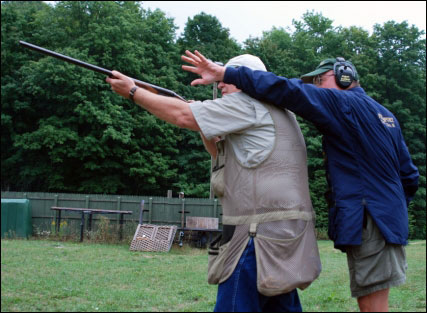 A professional gun fitting will yield the best results if the owner already understands and exhibits good fundamental shooting skills.
A professional gun fitting will yield the best results if the owner already understands and exhibits good fundamental shooting skills.The most obvious reason to seek out help with a gun fitting is usually either disappointing scores on clay target disciplines or miserable percentages of hits on live game. Nobody likes to come back to camp with an empty game bag, especially if they had a few good shots they should have made. Unfortunately, many shotgun enthusiasts may not consider a poorly fitted shotgun as the source of their problems. They may simply believe they’re poor shots.
Mr. Bilinski’s 30-plus years in the gun business indicate that folks often make conscious efforts to adjust their body fit a shotgun. The common observation is shared daily in gun shops throughout America. A prospective customer is either handed or picks up the shotgun of choice, they mount it improperly to their shoulder first, they then look down and focus at the bead or front “sight” of the gun, adjust their eye alignment down the barrel and then says “Ohhh, this gun fits me.”
This ready-to-buy affirmation is often confirmed by the commissioned salesman. “Yes sir, I agree, that gun looks like it fits you perfectly sir, should I wrap it up?”
For Mr. Bilinski and his clients, a complete try gun fitting is a journey that could take a couple hours up to an afternoon to perform properly. When asked, “How long does a fitting take?” he typically answers “I really don’t know yet. The time it takes to properly perform a gun fitting directly interrelates to your level of skill. It is difficult to fit someone who actually needs more help perfecting their gun mounting skills before being able to take advantage of the value of a gunfitting session.”
One of the first elements he always checks before starting the fitting session is “eye dominance.” Knowing which eye is dominant is critical to shooting where you are looking and being able to be fitted properly.
Analyzing gun mounting abilities is also critical in gun fitting. If the components of the shotgun aren’t properly anchored at the five key contact points, more time will be needed to readjust and alter the try gun. A gun fitting simply cannot be rushed. If it takes four hours or more, so be it.
When a new client arrives for a custom gun fitting, Mr. Bilinski needs to evaluate their shooting style, including stance, forward posture and whether or not they begin every gun mount from a “ready position.” Even if a client shows up with a near-perfect gun mount, it’s still going to take time to navigate the gun-fitting process. Mr. Bilinski says that he tries not to radically change an individual’s shooting style providing there aren’t matters of glaringly bad technique. Every fitting is a process of discovery and evolution.
He likes to summarize gun fit down to two simple, words, “anchor point.” The top, rounded edge of the comb perfectly complements the underside ledge of your cheek bone (also known as the zeugmatic arch). When your gun fits you well, you should be able to anchor the comb under your zeugmatic arch and have perfect eye alignment related to the rib or center line of your shotgun. Unfortunately, too many shotgun shooters think they should mount the gun to the shoulder first, and then move their head and attempt to align their dominant eye to the rib. This type of gun mounting technique is fraught with problems. Mounting the stock to your face first promotes consistently good shooting.
Determining your ideal “length of pull” is also critical to a well fitted gun. When you shoot a gun with an ideal length of pull for you, the center of the comb, also known as the “drop at face,” allows you to anchor the gun properly under the zeugmatic arch and with minimal head movement. When all the critical measurements of a properly fit gun are established the gift of a perfectly fit gun launches you with confidence on your journey as a wingshooter.
Mr. Bilinski’s primary tool of choice for a live fire gun fitting is a fully articulated, operational shotgun called a try-gun. In fact, FIELDSPORT owns five different try-guns: two over/unders and three side by sides. A try gun features a fully articulated stock that can be altered to move up and down and left to right, while the length of pull and pitch are adjusted through two rails that slide in and out of a metal carriage fitted inside the butt stock.
After a gun-fitting session is completed, the client is given a fitting sheet that lists all the crucial measurements that a gun maker or stock maker needs to know in order to make a custom fitted stock for a “bespoke” shotgun.
In experienced hands, the try-gun is a forgiving tool, allowing the gun fitter to change dimensions relative to his observations during the fitting and also the actual pattern placement he sees and reads on the steel patterning plate. Mr. Bilinski explains the process is one that basically starts with a rough fit and end with a perfect fit. After the measurements are perfect for the person being fitted the results are confirmed on the fitting plate positioned 16 yards in front of the shooters eyes. One thing for sure, the fitting plate takes no prisoners and does not lie. Confidence comes from seeing that image of perfect pattern placement clearly evident on the fitting plate.
While shotgun fittings are increasing in demand among the male population of American shotgunners, women and youngsters also represent a growing segment of shotgun shooters in search of perfectly fitted shotguns.
 Mr. Bilinski is an expert in fitting shotguns for women.
Mr. Bilinski is an expert in fitting shotguns for women.Typically, most women are introduced to shotgunning by a well-intentioned but ill-advised husband, boyfriend or father. When gun fit finally enters into the scenario, the “significant other” assumes that by simply shortening the stock all the gun fit ills will be rectified. Normally, shortening the length of pull does help a high percentage of lady shooters, but that is akin to assuming that all women are the same height and body type (Ms. Average) and no other critical stock dimensions need to be changed.
Compared to the gun fit needs of men, women have an entirely different set of gun fit needs and standards to follow, but that’s another chapter on gun fit.
“Ultimately, an individual should leave a gun fitting session with one very important element, confidence,” says Mr. Bilinski. “Confidence that your gun not only shoots exactly where they are looking, but also is quite comfortable to shoot, the felt recoil being absorbed properly at all the key contact points of the body”.
So what does this service cost? When Mr. Bilinski utilizes his try guns, the cost averages around $ 450, a figure that is largely dependent on the time and effort it takes to complete the program. A person with a poor gun mount and a novice skill level takes a lot longer to fit than a Master Class shooter. When Mr. Bilinski does an “impact test” live fire gun fit analysis using your existing gun, the price is usually less. Regardless of the shooters skill level, he allocates three to four hours per fitting session.
When you think of all the money you spent on guns that didn’t fit and you couldn’t shoot worth a darn, the investment in a custom gun fitting is money well spent. Most shooters only need to have one or two fittings done throughout their entire life. Ultimately, a custom gun fitting is a small price to pay in the search for shotgunning perfection.
Irwin Greenstein is the Publisher of Shotgun Life. You can reach him at contact@shotgunlife.com.
Useful resources:

Irwin Greenstein is Publisher of Shotgun Life. Please send your comments to letters@shotgunlife.com.


Comments